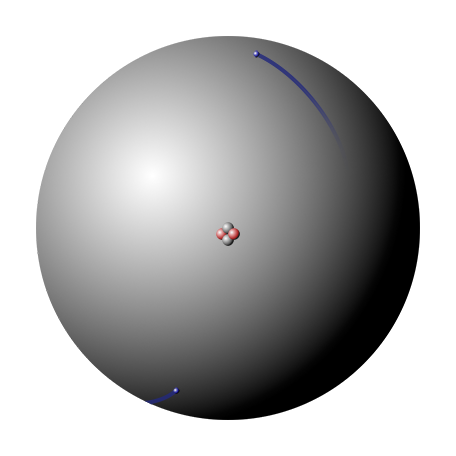[Originally published as the first part of Quantum Particles: An Introduction]
Quantum physics deals with how the universe behaves at very small scales – on the level of atoms and smaller. And it’s weird: very weird. Particles that are smaller than atoms do not behave in exactly the same way as the much larger objects to which we are accustomed. This makes quantum physics one of the most intriguing areas of research, and one which declares the glory and majesty of the Lord.
Atoms
We are taught in school that all matter is made up of very tiny particles called atoms. Some substances consist of only one type of atom — these are called elements. Gold, silver, lead, oxygen, carbon, hydrogen, helium, and aluminum are all examples of elements. The smallest particle of gold, for example, is a single atom. Amazingly, there are only about ninty naturally-occurring elements.
But atoms can also bond with other types of atoms to form a compound. Water is a common example. The smallest particle of water is not a single atom but a molecule made of two hydrogen atoms bonded to an oxygen atom. All the physical properties of any given substance are completely determined by the atoms that comprise it. And the properties of atoms are determined entirely by their constituent components and the rules of quantum physics.
For example, the fact that water is liquid at room temperature and standard atmospheric pressure is completely determined by the rules that define how the oxygen atom combines with the hydrogen atoms. It’s all quite complicated, and that’s the point. When God created this universe, He made certain kinds of particles and determined the rules that govern them so that life would be possible. That is a logical computation far beyond the capacity of all human minds combined!
Atoms themselves are composite particles; that is, they are made of smaller particles. One or more electrons swarm around the central nucleus of an atom. The cloud of electrons is what gives an atom its size. The central nucleus consists of one or more protons. Protons are larger and 1800 times more massive than electrons. Protons have a positive electrical charge, and electrons have a negative electrical charge equal in magnitude to the proton but opposite in sign.
Thus, there is a strong attractive force between the nucleus of an atom and the electrons swirling around it. This force is what keeps the high-speed electrons from escaping. Normally, the number of electrons surrounding the nucleus is equal to the number of protons in the nucleus. Thus, the atom has a net charge of zero.
In all elements except hydrogen, the nucleus also contains one or more neutrons. A neutron has no electrical charge but is about as massive as a proton. The mass of an atom is determined primarily by the sum of its protons and neutrons, with electrons having only a minimal contribution.

The properties of various substances are determined by the atoms of which they are composed. Gold, for example, is very heavy and dense. This is because a single atom of gold has 79 protons in its nucleus and (typically) 118 neutrons. Conversely, helium atoms have only two protons and typically two neutrons. Helium is therefore very light: lighter than air which is made primarily of nitrogen and oxygen. That’s why helium balloons float on air.
But the other properties are not as obvious. Why, for example, is gold a good conductor of electricity? Why does it have the yellowish color it does? Why is polished gold shiny? All of these properties are determined by the rules governing the way in which electrons swarm around the nucleus. And this is where the rules of quantum physics come into play.
Why Quantum?
The way in which electrons “orbit” the nucleus of an atom is similar in certain respects to how planets orbit the sun. Planets are bound to the sun by the attractive force of gravity, which bends their otherwise straight-line path into an approximate circle around the sun. Likewise, the negatively-charged electrons are bound to the positively-charged protons in the nucleus, causing them to orbit.
However, there are some differences as well. Planets can orbit at essentially any distance from the sun if they have the right velocity. Give a planet just a bit more energy, and it will move into a slightly larger orbit. But electrons orbiting the nucleus of an atom can only orbit at certain specific distances — and not in between.
Each distance is associated with a particular energy level — and there is a minimum energy level called the ground state.
- The ground state represents the closest an electron can circle the nucleus of an atom.
- The next level is called the first excited state.
- The level after that is the second excited state, and so on.
Thus, the energy levels at which electrons can exist in an atom are quantized (they come in discrete quantities). And this is what puts the “quantum” in quantum physics.
The Wave Nature of Matter
But why are electron levels quantized? The answer concerns the wave nature of matter.
Early in the history of physics, there was considerable debate about whether light was a wave or comprised of individual particles. We now know that light is (in a sense) both. It sometimes behaves like a wave, and other times it behaves as if it were made of particles. At first glance, this might seem contradictory because a wave is extended in space, whereas a particle has only a single location in space and is not extended.
Consider dropping a rock into a lake.
The splash will form a ripple pattern of concentric circles that expands with time. If the splash is large enough, the ripples might eventually fill the entire lake. So if we ask, “Where is the ripple?” The answer is, “Everywhere — it fills the surface of the lake.” But a single particle of infinitesimal size cannot do that. It exists at only one specific location in space at any given time.
Through a variety of experiments, physicists have discovered that light, electrons, and in fact, all particles have a wave nature. Under certain circumstances, they act as if they are a wave that fills a certain volume of space. At other times, they behave as if they are particles, existing at only one specific location in space. However, quantum particles never behave as both a wave and a particle at the same time. Thus, there is no contradiction.¹
So, when do quantum objects act like particles, and when do they act like waves? The answer is apparently that they act like particles when they are observed and like waves when they are not observed. This seems very peculiar for multiple reasons.
- How does the particle know it is being observed so as to change its behavior?
- How do we know it’s a wave when we are not observing it?
As to the first question, keep in mind that we cannot observe a quantum particle without affecting it. We tend to think of observation as passive. If we want to observe something large, we just shine a light on it, and the reflected light enters our eyes and informs us what the object looks like. Shining light on a large object doesn’t affect it very much because the object is so much more massive than the particles of light that impact it. But in the quantum world, particles are so small that anything we use to observe them will have a significant effect on the particle.
To be continued…
Footnote
A contradiction is “A and not-A at the same time and in the same sense.” An electron sometimes behaves as a wave (extended in space) and other times as a particle (not extended in space), but never both at the same time.







